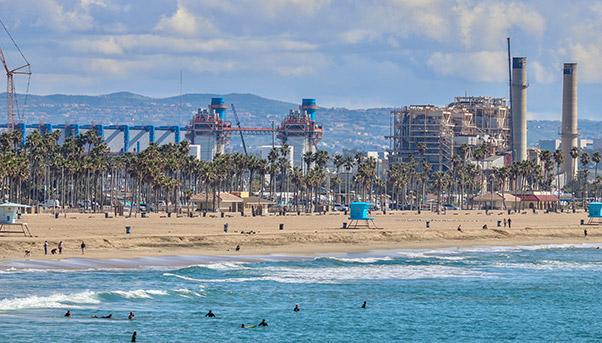
The water’s journey begins off the coast, at a plant located just a step away from the Pacific Ocean. Here, after three hours of treatment by a sophisticated purification and desalination system, what used to be undrinkable seawater is pumped to San Diego where it pours from the tap in hundreds of thousands of homes. This long journey would not be possible without the Carlsbad Desalination Plant, which transforms 50 million gallons of seawater (equal to 190 million liters) every day into a drinkable water supply for 400,000 inhabitants of San Diego and its surrounding area.
The plant, inaugurated in 2015 after an investment of $1 billion, is the most technologically advanced in the Western hemisphere. Above all, it is an opportunity for a region that has always been plagued by drought and water scarcity. California Governor Gavin Newsom said in a recent State of the State speech that citizens need «a fresh approach» to face «massive water challenges». Actually, according to statistics published by the US Drought Monitor, 36.9% of California’s population suffers from water scarcity. Faced with this crisis, one of the ways to tackle the problem, is to rely on desalination, even though today only 2% of the drinking water consumed in California comes from this kind of plant.
Carlsbad, an example to imitate
The umpteenth appeal to invest in desalination treatment was launched a few days ago by former Senator Barbara Boxer of California in the “Pasadena Star-News”: «As Californians, I believe we must look west to the Pacific Ocean, where seawater desalination offers a proven, climate change-resilient solution. No longer do we need verification from Israel, the Middle East and Australia, where desalination facilities have literally helped save lives and fend off debilitating droughts due to climate change. Now, we can look closer to home – in San Diego».
The Carlsbad Desalination Plant is not only the most technologically advanced in the Western hemisphere, it is also the largest and most ecologically sustainable. In its first 36 months of operation, it produced 40 billion gallons of drinking water (150 billion liters) for San Diego County – an amount that would fill the Empire State Building 145 times over. This achievement was made even more significant because it came during a very tough period when California was hit by a long and violent drought.

Desalination Plant, Huntington Beach, California
Another massive desalination plant in the works
The benefits demonstrated by the San Diego plant are convincing California to invest in another massive new plant. The Huntington Beach Desalination Project, once finished, will have the same treatment capacity as Carlsbad.
The approval process is on its way, and according to Poseidon (the company that built and now manages the Carlsbad) the new plant could be up and running this year. But no final timetable to start construction has been set, because of a series of administrative procedures that still must be completed.
Huntington’s goal will be to secure water supplies for Orange County in Southern California, one of the areas most affected by drought. Currently, Orange County is served by a few watersheds, such as the Sacramento River Delta or the Colorado River. These are insufficient to meet the current and future needs of this county of 3.2 million, which by 2040 will see its population increase by 350,000, according to the US Census Bureau.
According to its supporters, the Huntington Beach Desalination Project will play a strategic role in equipping the state with another infrastructure capable of responding to the needs of the region. The plant will be 100% carbon neutral and therefore will minimize any negative impact on the environment.
A coast dotted by small plants
These major projects can significantly influence the supply of water, but they also attract criticism from environmentalists complaining about excessive energy consumption. That’s why the California coast will soon be dotted with several smaller desalination plants, designed to meet the needs of the individual communities.
The small city of Antioch, with a population of around 100,000 inhabitants, has been awarded $10 million of the state’s $44 million earmarke for the construction of desalination plants. The goal for the city is to start the construction of a plant at the beginning of this year and to complete it within the next 18 months.
However, Antioch’s example is just one of many: Orange County and the city of Santa Barbara are organizing to build a plant on the coast, and have already obtained the funds from the state government; meanwhile the city of Camarillo, located in Ventura County, wants to build an inland plant to treat water discovered in the desert.
These individual plans are made possible by a California state directive. In 2014, the government approved Proposition 1, enabling it to allocate $7.5 billion to support the construction of new desalination plants, which are considered strategic in responding to the 2013-2017 five-year drought. It was a starting point in an attempt to respond to a now-chronic emergency on which the future of California depends.

